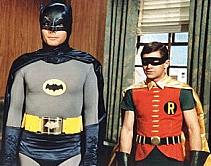
ABC television was interested in featuring a series based on a comic strip character in their 7.30 pm slot. They’d drawn up a list of five possible choices, based on popularity: Dick Tracy, Superman, Batman, The Green Hornet and Little Orphan Annie. As the rights to the first two character on the list weren’t available, they decided to go ahead with a ‘Batman’ project.
 The Batman character was originally created for detective Comics in 1939 by Bob Kane. Produced by American network ABC, the first television series exploded on to prime time television on January 12th 1966 after a multi-million dollar advertising campaign. The show was originally transmitted twice a week, on consecutive nights, with the first night always leaving either or both the Dynamic Duo in mortal danger at the hands of one of their outrageous arch-enemies. This was a ploy also used in the comic book version, the plot of which was, in nearly all ways, followed closely by the TV programme creators......
The Batman character was originally created for detective Comics in 1939 by Bob Kane. Produced by American network ABC, the first television series exploded on to prime time television on January 12th 1966 after a multi-million dollar advertising campaign. The show was originally transmitted twice a week, on consecutive nights, with the first night always leaving either or both the Dynamic Duo in mortal danger at the hands of one of their outrageous arch-enemies. This was a ploy also used in the comic book version, the plot of which was, in nearly all ways, followed closely by the TV programme creators......
Reportedly, DC Comics commissioned publicity photos of Henry in a Batman costume. Around this same time, the Playboy Club in Chicago was screening the Batmanserials (1943's Batman and 1949's Batman and Robin) on Saturday nights. It became very popular. East coast ABC executive Yale Udoff, a Batman fan in his childhood, attended one of these parties at the Playboy Club and was impressed with the reaction the serials were eliciting. He contacted ABC executives Harve Bennett and Edgar J.Scherick, who were already considering developing a television series based on a comic strip action hero, to suggest a prime time Batman series in the hip and fun style of The Man form U.N.C.L.E. .When negotiations between CBS and Graham stalled, DC Comics quickly reobtained rights and made the deal with ABC, who farmed the rights out to 20th Century Fox to produce the series.


Similar in style and content to the 1940s serials, Batman and Robin would arrive in the Batcave in full costume and jump into the Batmobile, with Batman in the driver's seat. Robin would say, "Atomic batteries to power...turbines to speed." Batman would respond, "Roger, ready to move out," and the two would drive out of the cave at high speed. As the Batmobile approached the mouth of the cave (actually a tunnel entrance in Los Angeles's Bronson Canyon) a hinged barrier dropped down to allow the car to exit onto the road. Scenes of Batman and Robin sliding down the Batpoles in the Batcave, to the arrival at Commissioner Gordon's building in the Batmobile (while the episode credits are shown), are reused footage that is used in nearly all part-one and single episodes.
After arriving at Commissioner Gordon's office, the initial discussion of the crime usually led to Batman and Robin conducting their investigation alone. This investigation usually resulted in a meeting with the villain, with the heroes getting involved in a fight and the villain getting away, leaving a series of unlikely clues for the two to investigate. Later, they would face the villain again, and he or she would capture one or both of the heroes and place them in a death trap with a cliffhanger ending which was usually resolved in the first few minutes of the next episode.

Near the end of the third season, ABC planned to cut the budget even further by eliminating Robin and Chief O'Hara, and making Bat girl Batman's full-time partner. Both Dozier and West were against this idea, and ABC cancelled the show. Weeks later, NBC offered to pick the show up for a fourth season and even restore it to its original twice-a-week format, if the sets were still available for use. However, Fox had already demolished the sets a week before. NBC had no interest in paying the $800,000 for the rebuild, so the offer was withdrawn.

No comments:
Post a Comment